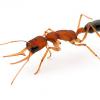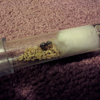I can see how feeding colonies in test tubes can be a little tedious, especially with small and fast ants. So I was wondering if maybe you could freeze them before feeding (for 5 minutes or less; basically chilling, not freezing)? I don't know if this would harm the queen or brood, and i'm sort of scared to try it. I suppose I could put the colony in a tubs & tubes setup instead.
NOTE: I don't actually have any colonies yet, so the more info I can get on this, the better.























